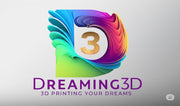
In the ever-evolving landscape of technology, the convergence of 3D printing and blockchain has emerged as a groundbreaking tandem that holds the potential to revolutionize various industries. While 3D printing has been transforming the way we manufacture physical objects, blockchain technology has been disrupting traditional systems of trust and transparency. This blog post delves into the exciting possibilities that arise when these two powerful technologies join forces.
- Enhancing Supply Chain Management:
The fusion of 3D printing and blockchain can lead to a more transparent and efficient supply chain. Blockchain's decentralized ledger ensures that every step of the manufacturing process is recorded and immutable. This transparency minimizes the risk of counterfeiting and ensures the authenticity of 3D-printed products. Each component's journey, from design to production and distribution, can be securely tracked using blockchain, creating an unbroken chain of trust.
- Securing Intellectual Property:
One of the challenges associated with 3D printing is the potential for intellectual property (IP) theft. By integrating blockchain, a tamper-proof record of the design and production process is created. Smart contracts on the blockchain can enforce licensing agreements automatically, ensuring that designers and creators are appropriately compensated for their work. This secure and automated approach to IP protection fosters innovation and creativity within the 3D printing space.
- Decentralized Manufacturing:
Blockchain enables the creation of decentralized manufacturing networks, where 3D printing can be leveraged to produce goods locally, on-demand. This decentralized approach has the potential to reduce shipping costs, decrease environmental impact, and empower local economies. Smart contracts on the blockchain can automate payment processes, creating a seamless and trustless exchange of value between manufacturers, designers, and consumers.
- Quality Assurance and Certification:
Ensuring the quality and authenticity of 3D-printed products is crucial, especially in industries like aerospace and healthcare. Blockchain can be used to create a digital thread that traces the entire production history of each item, including the materials used, production methods, and testing results. This not only enhances quality assurance but also streamlines the certification process, as regulators can access a transparent and verifiable record of compliance.
- Tokenization of 3D Models:
Blockchain introduces the concept of tokenization, allowing 3D models to be represented as unique tokens on the blockchain. This tokenization enables fractional ownership, where multiple stakeholders can have a share in the intellectual property or revenue generated by a particular 3D model. This opens up new possibilities for collaborative design efforts and ensures that contributors are fairly rewarded for their contributions.
Conclusion:
The combination of 3D printing and blockchain technology is a powerful synergy that holds immense potential for transforming industries and reshaping the way we approach manufacturing. From enhancing supply chain transparency to securing intellectual property and enabling decentralized manufacturing, the integration of these technologies opens up exciting possibilities for a more efficient, secure, and collaborative future. As these innovations continue to evolve, we can expect a paradigm shift in the way we create and consume physical objects in the digital age.
